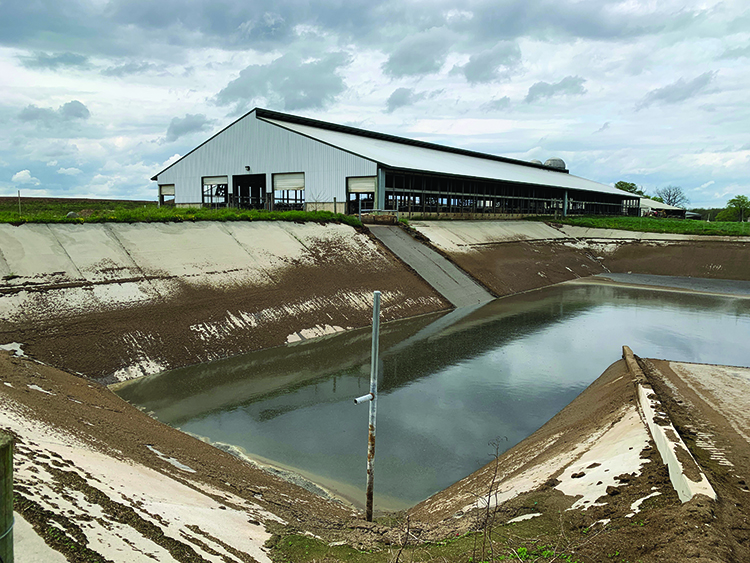The author is an environmental management educator with Michigan State University Extension.

As we experience more variable weather, like frequent and stronger storms, it has become more crucial that livestock producers check and monitor the integrity of earthen or concrete storage structures and manure transfer equipment. Wear and tear, as well as winter weather, can take its toll on the equipment depended upon to move manure from collection points to long-term storage structures. Spills may be caused by burst or ruptured piping, leaking joints, or failures of the storage.
Monitor the condition of manure storage structures as well as all manure transfer pipes, pumps, and valves to ensure they are performing as expected. Develop a regular schedule to inspect each component of manure storage and pumping equipment. Create a checklist of items to be inspected, including dates and times of inspection, to ensure a thorough, timely, and regular process.
Farm size and complexity of the manure storage system, mechanical devices, distance to surface water and wells, type of storage structure, and occurrence of rainfall or snowmelt should all be considered when determining inspection frequency. Regular checks and maintenance of all pumps, agitators, piping, valves, and other mechanical and electrical equipment will confirm everything is in good operating condition and minimize the risk of any spills or leaks.
Check the structure
For all storage structures, especially earthen, cautiously walk the perimeter of the storage based on your rainfall amounts, weather forecasts, and storage situation. Recognize that berms for earthen storages, just like fields, may be water saturated and weakened.
Assess how solid the sides are, looking for low points or areas with lower structural integrity. Roots from invasive plants and animal damage can contribute to manure storage weakness. The extreme cold may necessitate checking more often due to the depth of frost in the ground that puts external stress on a pipe.
Plan for emergencies
Each farm location has unique risks for manure to reach surface waters. Assess your risk, consider what the worst-case scenario might be, and think through a plan to address that situation before it occurs.
Identifying what is in the down slope direction from the storage will help you think through what sensitive areas are along that path and how critical the risks could be. Know how to get earth moving equipment on site as soon as possible and plan where potential berms would need to be built to divert the flow from reaching surface water, neighboring properties, or roadways.
Even when there are not imminent risks to surface waters, have plans in place to contain, control, and stop manure from moving overland. If your farm doesn’t have a written plan, you can learn how by reading the Michigan State University (MSU) Extension bulletin E-2575s, “Emergency planning for the farm: Livestock operations.”
Keep clean water clean
A manure storage structure that captures excess clean water runoff from around the farmstead, in addition to direct rainfall, obviously fills up even faster. Diverting clean water from reaching the lagoon would help maintain needed storage space. Gutters and downspouts on all the buildings, especially ones near livestock lots, can divert clean water away from manure and other contaminants. It also helps with relieving pressure on the manure storage freeboard situation.
Roof runoff is a cost sharable practice through the Environmental Quality Incentives Program (EQIP). Contact your local Natural Resources Conservation Service (NRCS) office for more information.
Be sure to exclude livestock from rivers and streams. Fencing and flash grazing are also important practices to keep surface water clean. Maintained buffers around surface water and sacrifice lots are valuable tools, as they can capture any contaminated lot or roof runoff before it reaches clean surface water.
Maintain extra space
Rain has a way of making spring fieldwork difficult, slowing the progress of all fieldwork — including emptying in-ground manure storages. Freeboard is the top area of a storage structure that is reserved for emergencies. The more rain that falls, the more freeboard space disappears in the storage, and there is less opportunity to spread manure without getting stuck.
What can you do? If your manure storage is looking dangerously full, there are some actions you can take to relieve the situation and the impending environmental emergency. There are no simple solutions, but thinking through your specific situation and monitoring it daily can help prevent, or at least minimize, environmental risks and potential regulatory issues.
For starters, design outside manure storages with freeboard to deal with extreme spring weather. Freeboard is typically 12 inches (6 inches for fabricated structures), plus the additional storage volume necessary to contain the precipitation and runoff from a 25-year, 24-hour storm event for your region.
Do everything you can to reduce liquid manure storage before it is alarmingly close to overflowing. Even relieving a few inches off the top will buy some time and reduce stress on the storage system.
If you find yourself getting close to freeboard, you can haul to your driest field or a field with a growing perennial crop growing like alfalfa or grass, keeping in mind crop damage may occur. There is a significant possibility you will damage your hay stand, and any time you are on wet fields, compaction will occur.
You could also transfer some manure to a different storage system, whether that be on your farm or that of a family member or neighbor. If you can’t haul to your own fields or transfer to a different storage system, see if you can haul to a neighbors’ field(s). Review the neighbor’s nutrient management plan with them and follow it.
In the event that a manure storage breaches and manure reaches surface waters, contact your region’s pollution hotline immediately. Reacting promptly can help minimize the impacts in a negative situation.
This article appeared in the August 2021 issue of Journal of Nutrient Management on pages 18 and 19. Not a subscriber? Click to get the print magazine.




